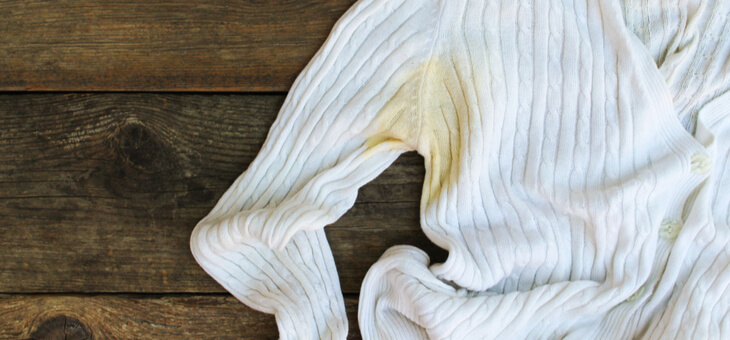White clothes can take on that yellow hue even when you’re following all the laundry rules perfectly. It might even only become noticeable when you purchase a new white item and hang it up in your wardrobe next to a now obviously stained T-shirt.
The same goes for smells. Sometimes it’s hard to shift the smell of sweat, especially when it comes to your favourite workout outfit.
Luckily, there are a few things you can do to prevent and reverse these issues.
Why does sweat stain?
Sweat marks occur when the proteins in your sweat react with the aluminium and other chemicals present in antiperspirants.
Apocrine sweat glands, which are the glands found in your underarms, produce a different type of sweat compared to eccrine sweat glands (found elsewhere on your body). Unlike eccrine sweat, apocrine sweat is full of fats and proteins, which contribute to stains and odour.
Sweat itself is sterile and virtually odourless, but when it meets the bacteria on the surface of your skin it can produce an unpleasant smell.
Wash your clothes promptly
If you wear an item for a significant amount of time, it’s likely to have some sweat on it. Stains and odours are caused when bacteria are left on fabric, so the best thing to do is launder clothing soon after each wear.
Essentially, the longer you leave sweat on clothing, the greater the bacterial growth.
If you can, try to air clothes out by hanging them over the side of the laundry basket so the bacteria don’t multiply and transfer to other clothes.
If you’ve just done a workout and don’t plan to do laundry for the next few days, pop your gym clothes in a plastic bag, tie it up and place it in the freezer. The cold will destroy the bacteria and prevent the clothes from festering in the bottom of the hamper until laundry day.
Spot clean the worst areas
Cleaning the armpits and neck area of shirts can help prevent yellow stains and lingering odours. Use a natural soap such as coconut oil or eucalyptus, or a laundry product specifically designed for spot treating.
If using natural soap, gently rub the product into the affected areas, being careful not to scrub too hard. Leave it to work for a few minutes before rinsing under cold water and washing as usual.
If using a laundry product, apply the product according to the directions on the packet.
Spot cleans are great because sweat stains and odours can require more attention or different temperatures than the recommended wash cycle for the rest of the garment.
Stains might not show up straight away
If you have a special-occasion outfit that you don’t wear too often, be wary about putting the garment away without laundering it, even if there are no obvious stains. Sweat can cause a reaction if left on a garment for a period of time, especially on a particularly delicate fabric such as silk. The next time you go to wear it, you might be met with an odour or stain that wasn’t there when you put it away.
A quick hand wash or a stop at the dry cleaners can prevent this.
Choose natural fibres
Due to their distinctive properties, natural fibres such as cotton, wool and silk react differently to sweat than synthetic fibres such as polyester and elastane.
Polyester often absorbs the oily sweat from armpits which can cause long-term odour.
A 2016 study from Norway found that even odour-control synthetic fabrics smell worse than natural fibres over time.
Use enough laundry detergent
You’ve probably heard not to add too much laundry detergent plenty of times, but it’s important that you’re not adding too little either.
If an insufficient quantity of detergent is used, some dirt and grime may remain on the fabric, giving it a chance to decompose and break down when dried and stored. This often results in yellow spots or stains.
Just follow the instructions on the detergent packet and measure it correctly in relation to the weight of the clothes you’re washing.
Change your deodorant routine
You may be applying antiperspirant incorrectly or using a product that isn’t suitable for your needs.
Make sure you don’t over-apply the product; you only need a few swipes. Piling on deodorant or antiperspirant will leave residue on your clothing that can make stains worse.
Consider switching to a natural deodorant. When you take the aluminium out of your antiperspirant, you are less likely to produce sweat marks. Just be aware that it can take a while to adjust to a natural deodorant and what works for one person won’t necessarily work for you.
If you have a beloved garment that you just can’t get a stain or odour out of, try cutting it out and replacing it with a patch of fresh fabric.
Transform blouses into sleeveless tops or add a cotton underarm gusset to protect the outer layer. If these things are beyond your sewing capability, they can be done easily by a professional tailor.
What’s your best laundry tip? Why not share it in the comments section below?

